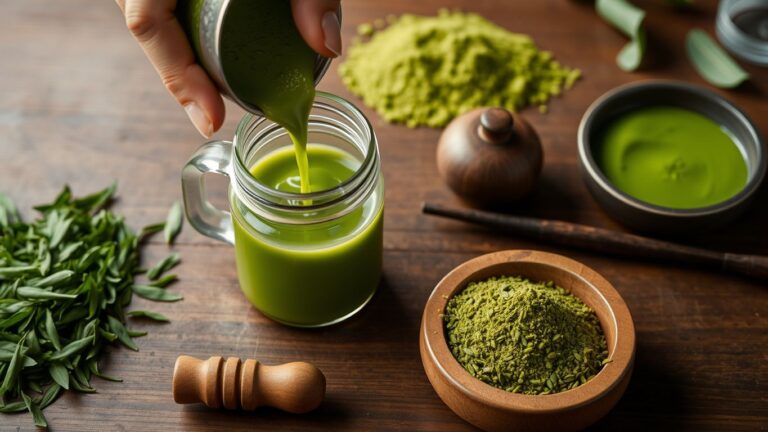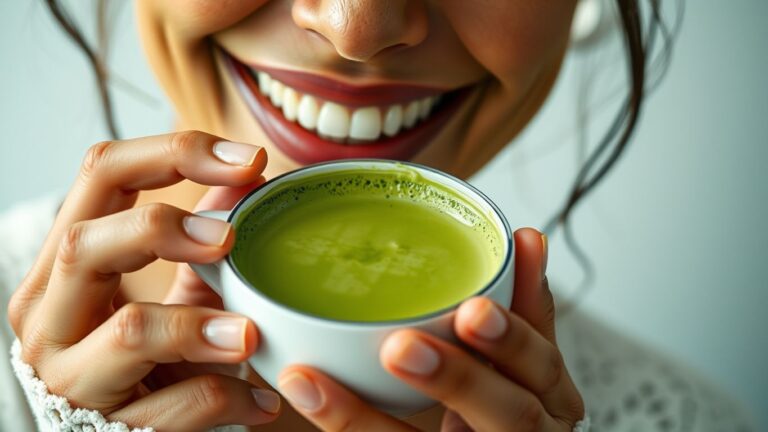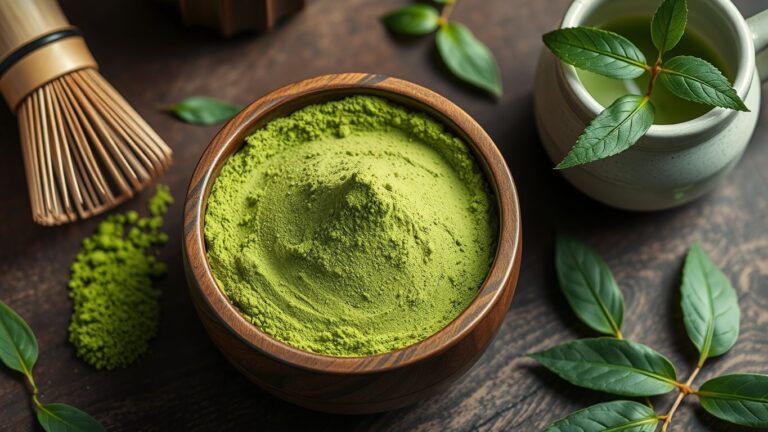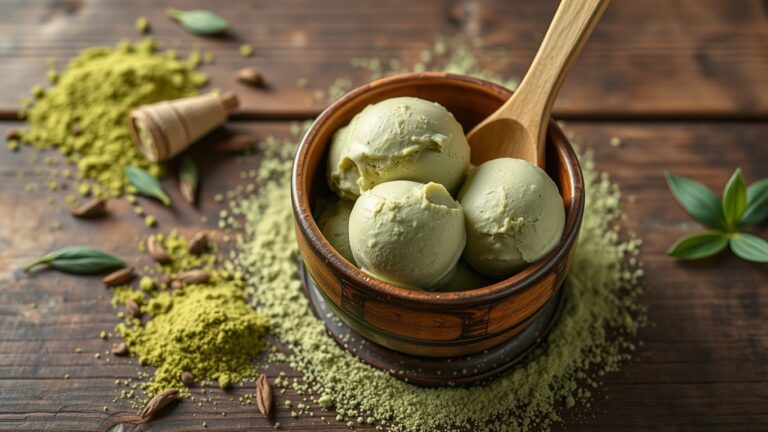Matcha, a powdered green tea, is known for its vibrant green color. This unique hue is not just visually appealing but also indicates the quality and health benefits of the tea. The green color of matcha comes from chlorophyll, which is abundant due to the special cultivation process. In this article, we will explore the science behind matcha’s green color, the different shades it can have, and why these variations matter.
Key Takeaways
- Matcha’s green color is due to its high chlorophyll content, which is boosted by shade-growing the tea leaves.
- The shade of green in matcha can indicate its quality, with brighter greens being more desirable for ceremonial use.
- Matcha color can change over time due to exposure to light, air, and moisture, affecting its quality and flavor.
- Different grades of matcha, such as culinary and ceremonial, have distinct color differences that reflect their intended use.
- The green color of matcha is linked to its health benefits, including antioxidant and detoxification properties.
The Science Behind Matcha’s Green Color
When you think of matcha, the first thing that likely comes to mind is its vibrant green color. But what makes matcha so green? Let’s dive into the science behind this unique hue.
Role of Chlorophyll in Matcha
Chlorophyll is the pigment responsible for the green color in plants, and matcha is no exception. The high chlorophyll content in matcha not only gives it its vibrant color but also acts as a powerful detoxifier. Chlorophyll helps eliminate heavy metals and toxins from your body, making matcha a healthy choice.
Shade-Grown Cultivation Process
The process of growing matcha is unique. During the final weeks before harvest, tea leaves are shaded from direct sunlight. This shading increases the chlorophyll production in the leaves, resulting in a more intense green color. The lack of sunlight also boosts the amino acid content, enhancing the tea’s flavor.
Impact of Photosynthesis on Color
Photosynthesis plays a crucial role in the color of matcha. By converting sunlight into energy, the chlorophyll in the leaves becomes more concentrated. This concentration is what gives matcha its bright green hue. The shading process limits photosynthesis, forcing the plant to produce more chlorophyll to compensate.
The vibrant green color of matcha is not just for show; it indicates a high level of chlorophyll and other beneficial compounds. This makes matcha not only visually appealing but also a powerhouse of health benefits.
Different Shades of Matcha Green

Matcha green tea comes in many shades, each with its own unique properties and uses. Understanding these shades can help you choose the right matcha for your needs, whether it’s for a traditional tea ceremony or a culinary creation.
Culinary vs. Ceremonial Matcha: Color Differences
When it comes to matcha, the color can tell you a lot about its quality and intended use. Ceremonial grade matcha and culinary grade matcha have distinct color differences that reflect their quality and purpose.
Culinary Matcha: Olive Green Hues
Culinary matcha is often used in cooking and baking. Its color is usually an olive green, which is less vibrant than ceremonial matcha. This type of matcha is more affordable and has a stronger, more bitter flavor, making it perfect for recipes where other ingredients can balance its taste.
Ceremonial Matcha: Vibrant Green
Ceremonial matcha is the highest quality matcha available. It has a bright, vibrant green color, which indicates that it has been carefully cultivated and processed. This type of matcha is meant to be enjoyed on its own, whisked into hot water, and savored for its smooth, umami flavor.
How Color Reflects Quality
The color of matcha is a key indicator of its quality. Bright green matcha is a sign of high-quality, fresh leaves that have been properly shaded and processed. On the other hand, dull or yellowish-green matcha often indicates lower quality or older leaves. When choosing matcha, always look for a vibrant green color to ensure you’re getting the best quality.
Why Matcha Color Changes Over Time

Matcha’s vibrant green color is a hallmark of its quality, but this hue can change over time due to various factors. Understanding these factors can help you maintain the best color and quality of your matcha.
Effects of Storage Conditions
Proper storage is crucial for keeping matcha’s bright green color. When matcha is stored improperly, it can lose its vibrant green color and start to turn yellowish or even brown. To maintain its color, store matcha in an airtight container away from light, air, and moisture. Proper storage can preserve the flavor and appearance of matcha for a longer period.
Oxidation and Exposure to Light
Exposure to light and air can cause oxidation, which affects the color of matcha. When matcha powder comes into contact with air, it can start to oxidize, leading to a duller color. Keeping matcha in a dark, cool place can help prevent this process and maintain its vibrant hue.
Maintaining Matcha’s Vibrant Green
To keep your matcha looking fresh and green, follow these simple steps:
- Store in an airtight container.
- Keep it in a cool, dark place.
- Avoid exposure to moisture.
By following these steps, you can enjoy the bright green color and fresh flavor of your matcha for a longer time.
Matcha’s color is not just about aesthetics; it also reflects its quality and freshness. Keeping your matcha properly stored ensures you get the best experience every time you use it.
Evaluating Matcha Quality Through Color
When it comes to matcha, the color is a key indicator of its quality. By understanding what to look for, you can easily distinguish between high-quality and lower-quality matcha. Here’s how you can evaluate matcha quality through its color.
What to Look For in High-Quality Matcha
High-quality matcha is characterized by a vibrant green color. This bright hue is a sign of good cultivation and processing. If the matcha appears dull or yellowish, it may indicate lower quality or improper storage.
Color Consistency and Uniformity
The color of matcha should be consistent throughout the powder. There should be no mottling or uneven coloration. Uniformity in color suggests that the matcha has been carefully processed.
Shade of Green and Flavor Profile
Different shades of green can indicate different flavors. Lighter greens are often milder and sweeter, while deeper greens can be more robust and bitter. The shade of green can give you insight into the type of matcha you’re dealing with, whether it’s for culinary or ceremonial use.
When evaluating matcha, always consider its color. A vibrant green hue is a hallmark of ceremonial grade matcha, which is the highest quality. This type of matcha is made from the youngest tea leaves, carefully grown in the shade to enhance their color and flavor.
Health Benefits Linked to Matcha’s Green Color

Antioxidant Properties of Chlorophyll
Matcha’s chlorophyll-rich green color is a sign of its health benefits. Chlorophyll acts as a powerful antioxidant, helping to protect your cells from damage caused by free radicals. This means that when you drink matcha, you’re not just enjoying a tasty beverage, but also giving your body a boost in its fight against harmful substances.
Detoxification Benefits
Chlorophyll in matcha also aids in detoxification. It helps your body remove toxins and heavy metals, making you feel more refreshed and energized. This detoxifying effect is one of the reasons why matcha is often included in health and wellness routines.
Overall Well-Being and Matcha
Drinking matcha can contribute to your overall well-being. The antioxidants and detoxifying properties of chlorophyll support your immune system and promote better health. So, the next time you sip on a cup of matcha, remember that its vibrant green hue is a sign of the many benefits it offers.
The Role of Color in Japanese Tea Ceremonies
In Japanese tea ceremonies, the color of matcha plays a significant role in creating a serene and visually appealing experience. The vibrant green hue of ceremonial matcha is not just for show; it symbolizes the quality and care put into its production. The green color of matcha is a reflection of the meticulous cultivation and processing methods used to produce this fine tea.
Modern Variations: Beyond Green Matcha
Matcha is famous for its vibrant green color, but did you know there are other colorful variations? These modern twists on traditional matcha offer unique flavors and visual appeal.
Color Psychology: Why Green is Good for You
Psychological Effects of Green
The color green is often linked to feelings of calm and relaxation. When you see green, it can remind you of nature, like lush plants and pristine landscapes. This connection to nature can make you feel more at peace and refreshed. Green is a calming color that can help you focus and feel more balanced.
Stress Relief and Healing
Green is believed to help relieve stress and promote healing. The American Psychological Association says that green can positively impact your thinking, relationships, and physical health. When you look at the vibrant green of matcha, it can make you feel more relaxed and even help your body heal.
Visual Appeal and Quality Indicators
The green color of matcha is not just pretty to look at; it also tells you a lot about its quality. The greener the matcha, the more chlorophyll and antioxidants it has. These compounds are good for your health and can make the tea taste better. So, when you see a bright green matcha, you know it’s packed with good stuff.
The vibrant green color of matcha is a sign of its high quality and health benefits. The greener the matcha, the more nutrients it contains, making it a great choice for both your mind and body.
Factors Influencing Matcha’s Final Color

Cultivation and Harvesting Techniques
The way matcha is grown and harvested plays a huge role in its final color. Shade-grown tea leaves are essential for producing high-quality matcha. By shading the tea plants for about three weeks before harvest, the leaves produce more chlorophyll, resulting in a vibrant green color. This process also enhances the flavor and nutritional content of the matcha.
Processing Methods
After harvesting, the tea leaves undergo several steps that affect their color. The leaves are steamed to prevent oxidation, which helps maintain their green hue. They are then dried and ground into a fine powder. Each of these steps must be done with precision to ensure the matcha retains its bright green color. Improper processing can lead to a dull or yellowish tint.
Environmental Factors
The environment where the tea plants are grown also impacts the color of matcha. Factors such as soil quality, climate, and altitude can influence the chlorophyll content in the leaves. For instance, tea plants grown in nutrient-rich soil and favorable climates tend to produce leaves with a more vibrant green color. Conversely, poor soil and harsh weather conditions can result in a less appealing color.
Proper cultivation, meticulous processing, and ideal environmental conditions are key to achieving the perfect green hue in matcha. By understanding these factors, you can better appreciate the effort that goes into producing high-quality matcha.
Conclusion
In the end, the color of matcha is more than just a visual treat; it’s a window into its quality, flavor, and health benefits. From the bright emerald greens of ceremonial matcha to the deeper hues of culinary grades, each shade tells a story of careful cultivation and processing. The vibrant green color, rich in chlorophyll, not only signifies a high-quality product but also brings a host of health benefits. So, the next time you enjoy a cup of matcha, take a moment to appreciate its unique green hue and the journey it represents from the tea fields to your cup.
Frequently Asked Questions
What gives matcha its green color?
Matcha gets its green color from chlorophyll, a pigment in plants that helps them make food from sunlight. The unique process of growing matcha in the shade increases its chlorophyll content, making it a vibrant green.
Why does matcha change color over time?
Matcha can change color if it’s exposed to light, air, or moisture. Proper storage in an airtight container away from light helps maintain its vibrant green hue.
Is matcha always green?
High-quality matcha is usually a bright green, but it can range from bright emerald to deep forest green. Lower quality or older matcha might appear yellowish-green.
What is the difference between culinary and ceremonial matcha?
Culinary matcha is usually darker and less vibrant, often olive green, and is used for cooking and baking. Ceremonial matcha is a bright, vibrant green and is used in traditional tea ceremonies.
How can I tell if matcha is high quality?
High-quality matcha is a vibrant green color, has a fine texture, and a rich, fresh aroma. Dull or yellowish matcha indicates lower quality or improper storage.
What are the health benefits of matcha’s green color?
The green color of matcha, due to its chlorophyll content, indicates high levels of antioxidants. These help detoxify the body and promote overall well-being.
Why is the color of matcha important in Japanese tea ceremonies?
In Japanese tea ceremonies, the vibrant green color of matcha is crucial for creating an aesthetically pleasing and authentic experience. It symbolizes purity and quality.
Are there other colors of matcha?
Yes, there are variations like blue matcha from butterfly pea flowers, red matcha from rooibos and hibiscus, and pink matcha from dragon fruit powder. These are not traditional matcha but are popular for their unique colors and flavors.






